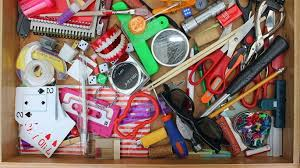
Plan: If playing virtually, grab 12-20 objects from your junk drawer and take a photo of them or find an image or someone else’s using a google search. If playing at home, grab objects and a bandanna or scarf.
Do: Show the image (or collection) of objects to the group. For younger students, ask them a few questions about the array to encourage observation skills, such as,” which objects do you also have in your house or which objects made of metal?” For older students, ask them to study the objects for 2-3 minutes. After time is up, challenge participants to recall all of the objects in the picture. Alternatively, provide a second picture with just one object missing, and challenge participants to identify the one missing object, either as a group or individually. If playing at home, you can take turns removing an object and trying to guess what’s been taken.
Reflect: Ask participants to share strategies they used to recall the objects. Were there particular things that were easier to remember? Why? Were there certain things that were harder to remember? Why? Did the observation of a teammate help you remember something additional? How else did working in a group help you during this task? If you did the difference variation, consider discussing whether it’s easier to notice similarities or differences.
Apply: Brainstorm strategies participants can use when overwhelmed, either to calm themselves or organize the incoming information to make it easier to digest. Share experiences where things seemed like a junk drawer and identify one object in the pile that symbolizes a problem-solving strategy.
Extend: Explore the hand model of the brain and ways to reduce a “flipped lid” or introduce a problem-solving strategy like ABCDE or goal setting strategy like SMART goals.
